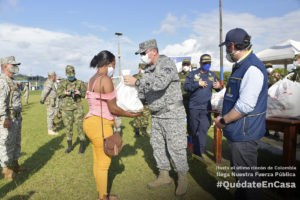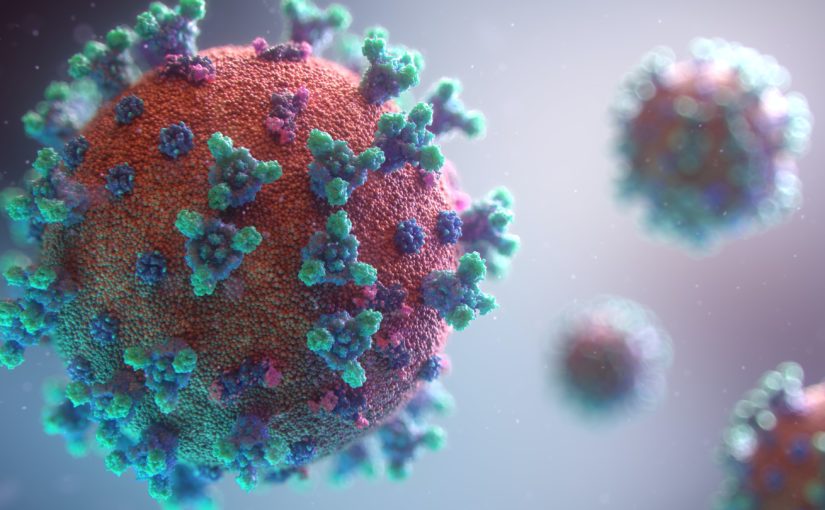
Colombia, which as of January 5, 2020, had 85,039 confirmed COVID-19 cases and 43,965 deaths related to COVID-19, finds itself trying to strike a balance between protecting its citizens, reactivating the economy, fighting still omnipresent crime and drug trafficking as well as continuing to implement peacebuilding measures following the country’s political conflict. The security forces are part of the state’s toolkit to contain the crisis and their contribution has essentially consisted of supporting quarantine enforcement activities and the provision of humanitarian aid.
The military in Colombia has provided humanitarian aid for a long time, but it does not officially rely on a framework to coordinate civil-military activities to do so. The closest thing resembling such a framework was the Damasco Doctrine, which is aimed at formalizing the support of civilian authorities in emergency situations following NATO standards. To contain the current crisis, the Ministry of Defense (MinDefensa) deployed 87,000 soldiers, policemen and policewomen as well as delivering essential items to vulnerable and isolated communities. In addition, by presidential decree, military recruits must serve three months longer than their actual contracts and the recruitment of new personnel was stopped. The Air Force uses light and medium cargo aircraft to supply food rations and evacuate sick people to hospitals. The Navy delivers humanitarian aid in landing craft originally intended for amphibious operations and troop transport. Finally, the defense industry in Bogotá redirected efforts towards the production of face masks, hospital beds and ventilators. This is a key contribution for areas where the population has lost their livelihoods due to the nation-wide quarantine or where health infrastructure is non-existent.
But pandemics pose a twofold challenge to militaries: They are not prepared to contain highly infectious diseases and soldiers inevitably clash with civilians when they directly participate in humanitarian action. This post elaborates on how these two caveats may undermine Colombian security forces’ legitimacy in times of COVID-19 in a country which struggles to keep their infection numbers low.
First of all, the ability of military actors to contain viruses or, at least, to act without being infected themselves are rather limited. Troops have historically contributed to the spread of infectious diseases, for example in the case of influenza in the United States by domestic troops during World War I, the spread of malaria from Afghanistan into the former USSR by Soviet troops; and more recently, cases of cholera brought by Nepali peacekeepers to Haiti. During the coronavirus crisis, the case of the aircraft carrier USS Roosevelt and the destroyer USS Kidd or the reduction of capabilities among European militaries due to COVID-19 highlight the vulnerability of armed forces in the face of infectious disease once more. A fast-spreading virus disables operational readiness, disrupts operations, and transforms highly mobile troops into effective spreaders, because militaries have a hard time following social distancing.
In Colombia, reporting following the troops suggest that troops do not necessarily contribute to containing the spread. By the beginning of April 2020, the national think tank Fundación Ideas para la Paz first warned about the impact the virus could have on the military. One month later, authorities reported one dead soldier and 57 service members infected with COVID-19 in a motorized Army battalion in Nariño province. In the Amazonas province, soldiers sent to restrict the virus spread by reducing the movement of the local population were infected themselves. The security forces at some point made up 11% of the total number of cases registered in the latter departamento. This example and the historical evidence suggest that military responders are, in fact, prone to rise infection numbers.
This is indeed a concerning issue. By June 2020, for instance, COVID-19 numbers in the Amazonas province were among the highest in the nation per millions inhabitants, while the region lacks intensive care units (ICUs) and borders with Brazil, now a country with the third-most cases worldwide. Although Southwestern province Nariño does not compare to Amazonas, it also shares an international border with another particularly hit country: Ecuador (as reported here and here).
Despite the delivery of much needed aid in such a context by the military is publicized and usually enjoys approval even by civilian oversight authorities, the operations of the military are paradoxically difficult to trace. In Nariño, ill soldiers were not isolated, but simply transferred to administrative duties, putting at risk other uniformed personnel and civilians in military bases. The Army, which had not commented on the practice before, declared that the governor of Nariño had not been authorized to reveal the information and that the institution would internally handle the cases. Similarly, in Amazonas the only reliable data on the spread among the troops themselves came from the Amazonian Secretary of Health. In this departamento, the Army and both municipal and regional administrations did not officially share information about the measures to handle the crisis, lest the number of infected and victims in the military. While the Secretary of Health estimated the number of infected soldiers as high as 240, unofficial versions coming from the Army itself, elevated the number to 350 as of May 2020. Making things worse, one soldier faced penal charges and three more are being investigated by the Attorney General’s Office for not adhering to the provisions of social distancing rules.
At the national level, the numbers are also difficult to trace: National authorities barely share data on the number of affected members. By early June 2020, newspapers, based on unofficial sources, claimed that at least 1,200 uniformed people were infected. They also reported the reluctance of the security authorities to provide official numbers on their affected members. One month later, the Ministry of Health and Social Protection – with data provided by MinDefensa – updated the number: 5,701 infected and 11 deceased. Since then, to the best of the author’s knowledge, no new data has been released on this issue.
Now put together the above-mentioned incidents pose the question whether military engagement in humanitarian action, usually legitimate but highly contested, does actually underpin the legitimacy of the security forces in Colombia. The humanitarian action, as it is exerted by the military, might not contribute to stopping infections as desired. On the contrary, it might be helping – in the worst case – to spread it. Therefore, decision makers in Colombia should seriously consider making data coming from the Ministry of Defense publicly available. Transparency is very much needed to assess the efficacy of the military institutions in dealing with pandemics. At its very core, transparency is a key democratic value to which Colombian citizens are entitled. For civilian decision makers and military planners, transparency means building legitimacy in the eyes of the civilian population, especially in rural areas. Otherwise, they may jeopardize – in the short to medium term – the standing of a key actor needed in bringing stability to a very unstable country.
(Hinweis: Der vorliegende Blog-Beitrag gibt nicht zwingend die Meinung des KFIBS e. V. wieder.)
(Bildnachweis für Beitragsbild: Photo by Fusion Medical Animation on Unsplash)

Picture:
Colombian Ministry of Defense publicity campaign.
Caption: “Our public force arrives to Colombia’s last corner #StayAtHome”

